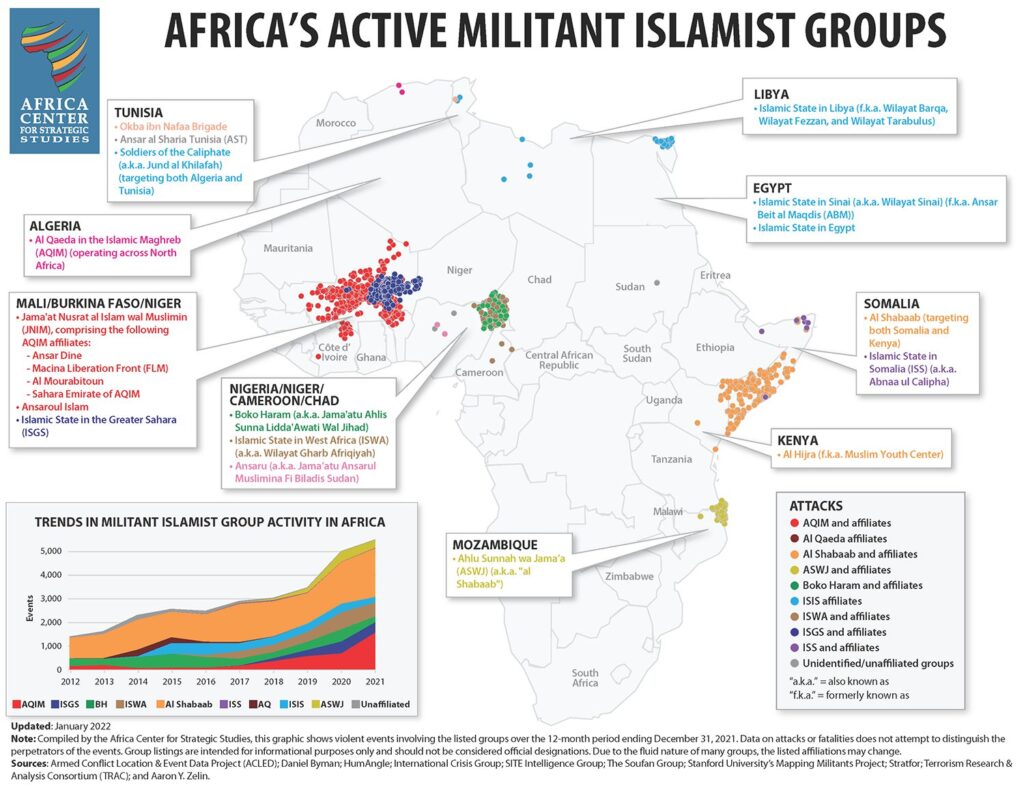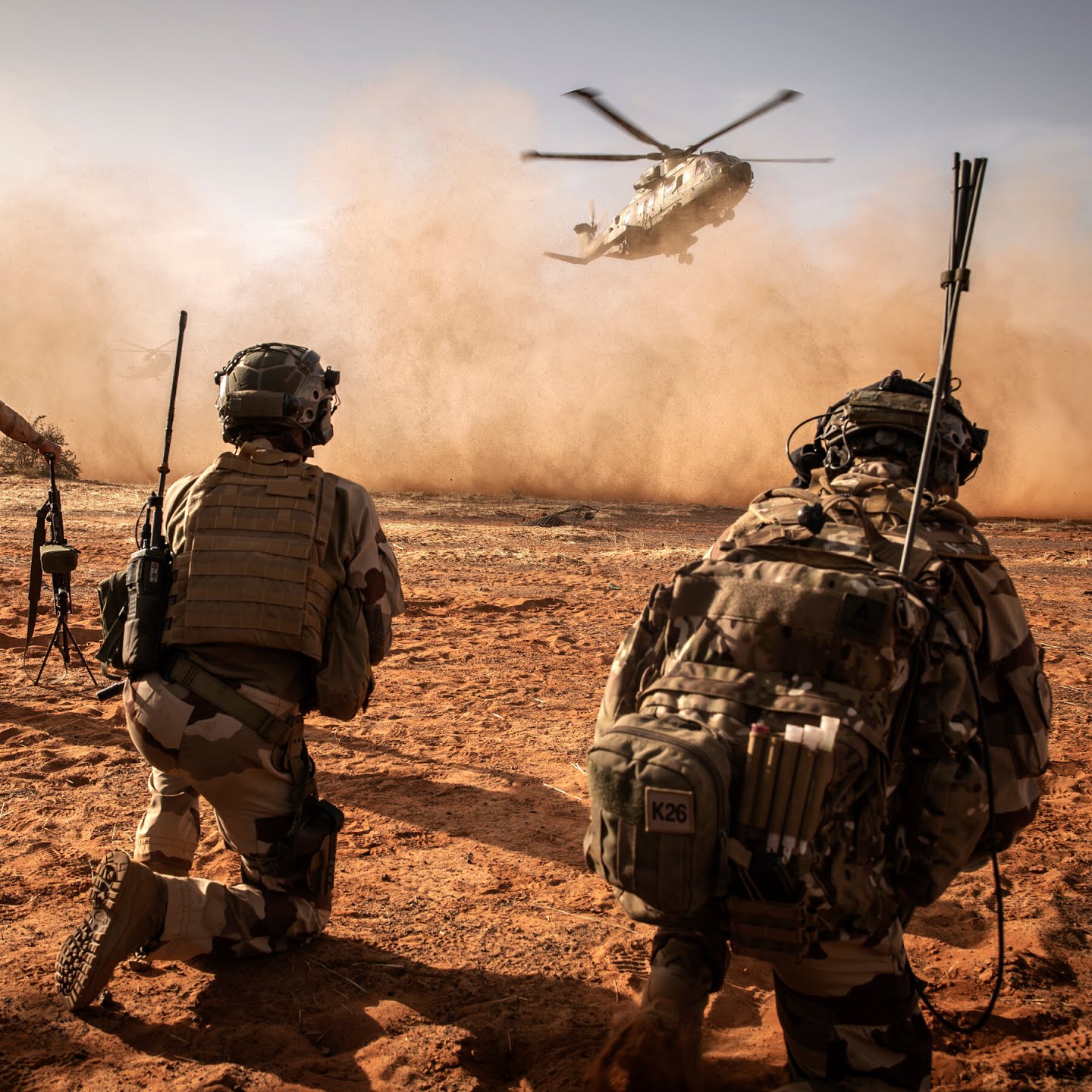By Africa Center for Strategic Studies
A 70-percent annual increase in violent events linked to militant Islamist groups in the Sahel propelled a new record of extremist violence in Africa in 2021.
A near doubling in violence linked to militant Islamist groups in the Sahel in 2021 (from 1,180 to 2,005 events) highlights the rapidly escalating security threat in this region. This spike was the most significant change in any of the theatres of militant Islamist group violence in Africa and overshadowed a 30-percent average decline of violent activity in the Lake Chad Basin, northern Mozambique, and North Africa regions.
Overall, militant Islamist group violence in Africa climbed 10 percent in 2021 setting a record of over 5 500 reported events linked to these groups. This continues an upward pattern seen since 2016. Nevertheless, the annual rate of increase was much less than the 43-percent increase reported in 2020.
Africa-wide, reported fatalities linked to militant Islamist groups dropped by 7 percent in 2021 over the previous year, to an estimated 12 700 deaths. This includes a 14-percent decline in fatalities linked to violence against civilians, revealing a decrease in every theatre except the Sahel.
Incidents of battles involving militant Islamist groups and both state and nonstate armed forces comprised 52 percent of all reported violent events in 2021. This reflects significant escalations in battles in northern Mozambique, Somalia, and the Sahel, continuing a trend from the past several years.
Militant Islamist violence in Africa remains largely concentrated in five theatres, each comprising distinct locally based actors and context-specific challenges: the Sahel, Somalia, the Lake Chad Basin, Mozambique, and North Africa.
Sahel
The 2 005 violent events observed in the Sahel (specifically Burkina Faso, Mali, and western Niger) in 2021 represent a 70-percent increase over the previous year. This continues an uninterrupted escalation of violence involving militant Islamist groups in the region since 2015. While having originated and still largely centred in Mali, the propensity of this violence has now shifted to Burkina Faso, which accounts for 58 percent of all events in the Sahel.
Two groups, the Macina Liberation Front (FLM) and the Islamic State of the Greater Sahara (ISGS), account for the majority of these violent attacks. FLM is part of a consortium of groups with ties to al Qaeda in the Islamic Maghreb known as Jama’at Nusrat al Islam wal Muslimin (JNIM).
The estimated 4 839 fatalities linked to these violent events in the Sahel in 2021 were 17 percent higher than the previous year. This follows a 57-percent increase reported in 2020. There are now more fatalities linked to militant Islamist groups in the Sahel than any other region in Africa.
Reported attacks on civilians (833) and related fatalities (1,332) in the Sahel roughly doubled from 2020. Militant Islamist group violence against civilians in the Sahel represents 60 percent of all such violence in Africa.

An observable consequence of such violence in the Sahel is the displacement of more than 2.4 million people, including more than 190 000 refugees and 2.2 million internally displaced. Burkina Faso accounts for the bulk of this displacement, with roughly 1.6 million displaced.
Battles between security forces and militant Islamist groups also increased over the last year—but varied greatly by group. Battles with JNIM groups increased by 50 percent, while engagements with ISGS saw a 45-percent decrease.
while engagements with ISGS saw a 45-percent decrease.
Somalia
There was a 17-percent increase in violent activity involving al Shabaab over the past year (from 1 771 reported events to 2 072) marking a steady increase—and near doubling—from the 1 080 events in 2015.
The Somali theatre accounts for 38 percent of all militant Islamist group events in Africa, roughly equivalent to the level of the Sahel. Despite consistent increases in al Shabaab activity in Somalia over the years, this represents a relative decline from its engagement in approximately half of all militant Islamist violence observed in Africa over much of the last decade—reflecting the escalating violence in other theatres, particularly the Sahel.
Almost three-quarters of the events linked to al Shabaab in 2021 were in the form of battles between al Shabaab and security forces. The number of battles increased by 32 percent in 2021, while attacks on civilians dropped 27 percent. Al Shabaab continues to try to leverage the political crises surrounding the delayed legislative and presidential elections to expand its influence.
Lake Chad
The 843 violent events observed in the Lake Chad Basin (straddling four countries: Nigeria, Cameroon, Chad, and southeastern Niger) in 2021 represent a 32-percent decrease in militant Islamist activity from the previous year. This reflects a notable turnabout from the upsurge in violence in 2020, though still corresponds to roughly 10 percent more incidents than in 2019.
The Lake Chad Basin also experienced a 21-percent drop in reported annual fatalities linked to militant Islamist groups. Boko Haram saw the largest drop (46 percent) while its offshoot, the Islamic State in West Africa (ISWA), observed just a 3-percent dip. This may have been due to the major transitions each group underwent in 2021, not the least of which included the death of Boko Haram’s longtime leader, Abubakar Shekau, in May.
Boko Haram and ISWA violence against civilians dropped by 49 percent in 2021. This was mirrored by similar declines in remote violence, such as IED’s and shellings, (33 percent) and battles (18 percent).
The upsurge in violence in northwest Nigeria is largely attributed to organized criminal gangs rather than militant Islamist groups.
Northern Mozambique
The number of reported violent incidents linked to militant Islamist groups in the Cabo Delgado Province of northern Mozambique dropped 25 percent in 2021 to 329—a dramatic change from the 129-percent increase reported in 2020.
For the first time since the insurgency began at the end of 2017, northeastern Mozambique saw more battles (56 percent) than violence against civilians (38 percent) in 2021. Attacks on civilians in 2021 dropped by 58 percent over the prior year.
The reported 1 067 fatalities in 2021 (of which 66 percent were associated with battles) mark a 33-percent drop from the previous year. Fatalities linked to violence against civilians declined by 60 percent. These falloffs in reported fatalities correspond with the deployment of troops from the Southern African Development Community (SADC) and Rwanda.
North Africa
The 234 violent events involving ISIS in North Africa in 2021 represent a continuing 5-year decline in incidents from its high point when there were 506 violent episodes linked to ISIS. Virtually all the reported activity in 2021 was in Egypt (about 95 percent). The 272 fatalities linked to these events represent a 52-percent drop from 2020—and a 14-fold decline from the over 4 000 fatalities experienced in 2015.
The Egyptian theatre is characterized by the longstanding conflict between the Egyptian military and militant Islamist groups mostly in the Sinai. In 2021, remote violence accounted for 55 percent of violent events and 45 percent of fatalities reported in the theatre, while battles accounted for 35 percent of events and 45 percent of deaths.
Credits | Defence Web, Africa Centre

